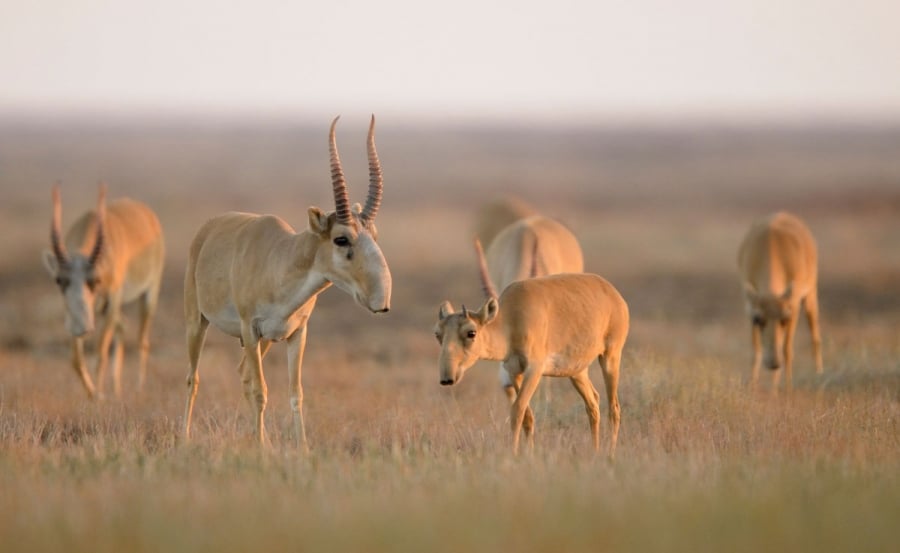The Mongolian Saiga is a wild animal that lives in the steppes of Mongolia and is known in English as the “Mongolian Saiga.” It belongs to a species of antelope and is known for being fast, agile, and resilient.
Mongolian Saigas form large herds numbering in the thousands, which move together as a natural phenomenon of their habitat. They primarily inhabit the steppe and graze on grasses. As a wild animal, the Mongolian Saiga holds significant ecological importance and has been the focus of various conservation efforts.
The Mongolian Saiga is a unique part of Mongolia’s natural environment and ecosystem and has also played a significant role in the lives, history, and culture of the Mongolian people.

Mongolian Saiga Status
The Mongolian Saiga is classified as critically endangered and a native species. According to the IUCN Red List criteria, it is internationally listed as “Vulnerable” and regionally also “Vulnerable.” In 2010, an international conference was held in Ulaanbaatar with representatives from all governments, scientific institutions, international organizations, and NGOs of the countries where the Saiga inhabits. During this conference, the Mongolian Saiga was recognized as a distinct species (Saiga borealis), and agreements among parties were revised.
Identification Features
Body length: 116 cm; shoulder height: 75 cm; weight: up to 32 kg. The horns can be up to 25 cm long, ringed with multiple grooves, light yellowish in color, and paired spiral horns are present. Females do not have horns. The summer coat is reddish-yellow, while the winter coat is pale gray. Newborn fawns have a brownish coat. The Saiga stretches its neck forward and lowers its head while running, reaching speeds of 60-70 km/h.
Distribution and Habitat
In the past century, the Mongolian Saiga inhabited the steppes from the depression of Uvs Lake to Red Lake, spreading across the Great Lakes Basin and surrounding steppe. By 1995, only about 20% of its previous range remained in two main areas. One population is located at Sharga, spreading around the Sharga Gobi’s front, west, and north, at the edges of the surrounding mountains and valleys. The other population remains in a small 400 km² area east of Khar Us Lake along the Mongolian Altai mountains’ slopes. This population is critically endangered. They inhabit altitudes between 1100-2200 m on gentle mountain slopes, grassy plains, and gravelly terrain with no significant obstacles. They graze in valleys and under hills, using shelter during cold snowy winters or dry summers. The Saiga is distributed in 3325 km² in Sharga Gobi, 6700 km² in Khuis Gobi, and 1173 km² in the Tavan Khairkhan and Chandmani plains.
Life Characteristics
The Mongolian Saiga moves intermittently following grass and water but does not migrate long distances. In Sharga Gobi, herds number up to 50 during winter but disperse into smaller groups in summer. Mating occurs in January, with a gestation period of about 5 months, and fawns are born in mid-June. Up to 16% of births are twins. Females begin breeding at 7 months, and males at 19 months. Their diet consists of about 30 species of grasses and shrubs including govi-specific species like taana, homuul, bagluur, and shaarilj. They drink little water when succulent plants like taana and homuul are abundant. They are parasitized by 17 species of helminths, 2 species of ticks, and 1 skin mite species. They are vulnerable to diseases from domestic livestock. Newborn fawns quickly adapt, grow healthily, and reproduce normally.
Population and Causes of Decline
Population numbers fluctuate significantly due to natural and human factors. In 1993, the Sharga population was about 1400, and the Mankhan population about 70 individuals. Density estimates were 5.9 Saigas per 1000 ha in Sharga Gobi (~1980 individuals), 1.6 per 1000 ha in Khuis Gobi (~1100 individuals), and 0.8 per 1000 ha in Chandmani (~160 individuals), totaling about 3240 Saigas. A joint survey by the Institute of Biology and WWF Mongolia in 2010-2012 estimated about 8000 Mongolian Saigas in Mongolia. Traditionally, the horns were used in Eastern folk medicine and meat was a local food source, but overhunting and habitat loss caused severe declines. Since the 1990s, illegal hunting has increased due to horn exports. Grazing pressure by humans and livestock has reduced grazing areas and water sources. Harsh winters and spring conditions cause mass mortality from starvation and cold. Predation by eagles and parasites also impact survival and fitness. The species is critically endangered and native.
Protection Status
Hunting has been prohibited by law since the 1930s. The species is listed as critically endangered under Mongolia’s Law on Animals, the Mongolian Red Book, the IUCN Red List, and Appendix II of the Convention on International Trade in Endangered Species of Wild Fauna and Flora (CITES). Sharga and Mankhan areas were designated as special protected reserves since 1993. Research on distribution, population, biology, and ecology is ongoing, along with captive breeding and reintroduction efforts.
Conservation Measures
Efforts include restricting and regulating roads that pass through Saiga habitats, enhancing monitoring along these roads, expanding protected area networks to cover Saiga habitats, captive breeding, reintroducing Saigas to former habitats, mitigating competition between livestock and Saigas for water and grazing, conducting detailed biological studies, stopping illegal hunting, involving local communities and co-management groups in protection and monitoring, strengthening law enforcement, and implementing biotechnical interventions during droughts, harsh winters, and disasters. Preservation of the gene pool is a priority.